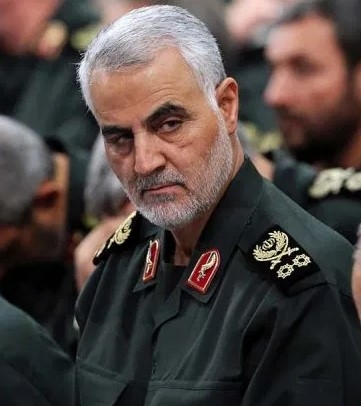
The U.S. drone strike killing of Iranian Quds Force commander Qasem Soleimani on Jan. 3 has real potential to dent Iran's malign activity in the Middle East, and beyond. But how long this effect might last is still very much an open question. The answer depends significantly on how the United States responds to future tests.
Soleimani was undoubtedly a central component of Iran's aggression and terrorist export program. The months leading up to his assassination provide prominent examples of that leadership.
The Iranian regime, led by Supreme Leader Ali Khamenei, has been economically bled by American sanctions, and it responded by activating Soleimani and his Quds Force, as well as the wider Islamic Revolutionary Guards Corps (IRGC), to take increasingly aggressive action.
These steps included a piracy-like campaign of mine attacks on international shipping in the Persian Gulf area, the June downing of an American drone, and September's surprise cruise missile and drone assault on Saudi oil fields. In that incident, 25 missiles and drone strikes caused substantial damage to the Saudi oil industry, and the Iranians exhibited high-end offensive capabilities, intimidating the Sunni-Arab countries.
The IRGC-Quds Force has also been busy proliferating these capabilities around the region. Soleimani's arms network planted advanced cruise missiles in Syria to target Israel, trafficked mid-range ballistic missiles to Shi'ite militias in Iraq, and proliferated long-range ballistic missiles to the Houthi forces in Yemen, who are also part of the Iranian terror axis, and who routinely fire missiles at Saudi cities.
Soleimani's role should be seen in the broader context of Iran's pattern of conduct. He was a key enabler in boosting the country's regional malign activity. His actions, and those of the broader IRGC, demonstrated to all that Iran had increased its confidence, abilities, and will to take bold action.
The assassination of Soleimani, and with it, the badly-needed restoration of American deterrence, has the potential to turn this trend on its head, due to Soleimani's unique role.
He was not just another military-terrorist commander. He formulated an entire doctrine that was based on the idea of installing armed proxies throughout the region, on the borders of Israel and U.S-allied Arab states, and using them to activate force. These proxies meant Iran could go much further than threatening the region with missiles on its territory.
Soleimani was not just another link in the chain of command, and it is far from clear whether his successor, Esmail Gha'ani, can take the same funds and resources that were at Soleimani's disposal and achieve the same things that Soleimani did.
This is due to the fact that part of Soleimani's power stemmed from his charismatic personality, which gave him the ability to fly to Russia in 2015 and convince President Vladimir Putin to become involved in the Syrian civil war on the side of the Assad regime. Soleimani's ability to sit down with President Assad to formulate a war strategy for defeating the Sunni rebels was also an expression of his character. Replicating these actions is not merely a question of funds or resources – a certain leadership personality is also required.
Still, it seems as if Gha'ani already is hard at work. The reported Feb. 14 airstrikes on Iranian targets around Damascus seems to be an indication of fresh IRGC-QF efforts to traffic advanced weapons into Syria.
Soleimani has also been a driving force behind the ongoing arms flow to Iran's Lebanese proxy force, Hizballah. Hizballah's arsenal of 150,000 rockets and missiles has been at the center of an Iranian upgrade effort, with the aim of taking some of the inaccurate projectiles and turning them into precision guided missiles (PGMs).
Hizballah, a terrorist army that is not accountable to any government except the Iranian regime, is considering building factories on Lebanese soil that would convert such rockets into PGMs. Israel has made it abundantly clear that it will not tolerate this development, and Soleimani's elimination from the scene, together with Israel's warnings, may help postpone Iranian-Hizballah plans for constructing such factories.
The creation of precision missile bases throughout the Middle East, which Iran could activate at any time against Israel, Arab-Sunni states, or American forces, has been a vision that Soleimani worked hard – with only partial success – at achieving.
An Israeli prevention campaign involving hundreds of air strikes stopped some of this vision from turning into reality, but Soleimani and his subordinates in the IRGC-QF were able to create a number of such missile bases.
An Iranian proxy like Hizballah, armed with the ability to hit targets within a 30-meter accuracy radius, means that terrorists can decide to hit a building with precision, causing major disruption in the targeted country. It also gives the Iranians and their proxies the ability to threaten strategic sites, or to try and kill high-profile leaders.
Within Iran, military industries continue to churn out accurate missiles, using miniaturized technology and new navigation technology. The IRGC-QF's role under Soleimani was to get those missiles into the hands of radical militias. It is safe to assume that Gha'ani, Soleimani's replacement, will try to continue that work.
Only consistent American, Israeli, and international determination to stop these actions has the potential to make Iran abandon this objective.
Still, the regional upheaval that Soleimani played a key role in fomenting is likely to have aftershocks well into the future. The war between the Iranian-Russian-Assad coalition and Sunni organizations created some 9.5 million displaced people in Syria, resulting in a whole generation of people that lack homes, jobs, or for that matter, hope.
The chances of people growing up under such conditions to be receptive to Westernized democratic outlooks is not very high. In contrast, messages from radical Islamist actors could be well received by youths who experience such unstable conditions, and the next recruitment ground for radical ideas is already taking shape.
Yaakov Lappin is a military and strategic affairs correspondent. He also conducts research and analysis for defense think tanks, and is the military correspondent for JNS. His book, The Virtual Caliphate, explores the online jihadist presence.
